The Growing Threat of Lightning Damage & the Campaign to Counter It
Instances of lightning damage onboard yachts are steadily increasing, posing safety risks, cost increases and decreased usage time for yacht owners around the world. The results can be catastrophic. So, we have invited North Technology Group mast and rigging brands Southern Spars, Future Fibres, Hall Spars and RigPro to contribute with some of their latest research.
Having invested significant time and resources in this area, the group is determined to innovate for this growing problem.
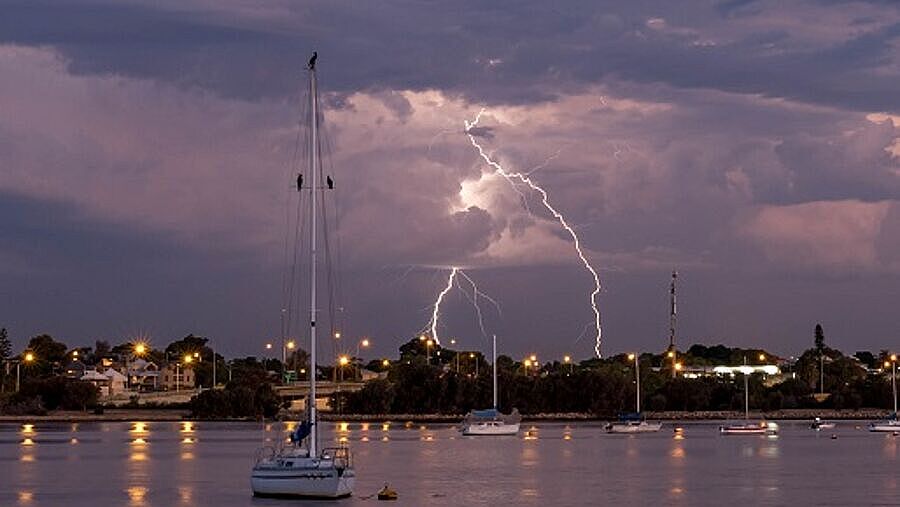
Understanding The Trend
“Like being struck by lightning” describes something highly unlikely coming to pass. But for yacht owners, lightning damage shouldn’t be a major surprise. Globally, lightning strikes the Earth around 8 million times every day, and the chance of a yacht being struck in lightning-prone areas is between 0.39 and 0.69 per cent. Traditionally these areas include the Caribbean, Florida and the Mexican Gulf, but the balance is rapidly changing as the risk increases in other locations. At Pantaenius, the share of the Mediterranean in all lightning-related claims has grown from 5 to 12 per cent over the last years.
As global warming intensifies, the frequency of lightning strikes is projected to increase by 12 per cent with every degree of temperature change—that’s 50 per cent before the end of the century. Some climate models suggest the increase could be closer to 60 per cent, making this an increasingly urgent issue.
Climate Change
The ramifications of climate change are far-reaching, and many fail to hit home until they begin to affect us directly. The reshaping of our weather patterns, which is leading to more severe and frequent storms, could make some of sailing’s most sought-after locations undesirable in the near future.
Coastal regions around Central America, especially areas like Panama and Costa Rica, are major hotspots for lightning strikes, posing particular challenges given the limited infrastructure in some of these areas to handle lightning-stricken yachts.

Tropical regions and equatorial waters, with their obvious alluring beauty for sailors, are also zones of high electrical activity. Yachts in these waters, with their tall masts standing as lone conductors against the vastness of the sea, become involuntary lightning rods and stand a much-increased risk of being struck.
Increased Exposure
There's also a broader trend of a growing number of large yachts being launched. With more large vessels on the horizon, the pool of potential targets for lightning expands. Combine this with modern yachts’ intricate electronic systems, and the financial implications of lightning-induced damage escalate.
While direct strikes are a palpable threat, nearby strikes can be just as menacing. Induced electrical currents from a strike, even several miles away, can play havoc with onboard electronics, while many mistakenly believe they're safe from a distant storm.
The need of the hour is comprehensive awareness, encompassing not just the imminent risks but also measures to mitigate and respond to them. It's crucial that the industry reframes lightning damage from being a rare occurrence to a common eventuality that demands respect and due preparation.
While awareness is increasing, many remain unaware of the risks and how to negate them.
The Risks
There’s very little chance of being hurt by a direct lightning strike while onboard your yacht. Leading risks are extensive damage to the rig, rigging, electronics, or other equipment.
Representatives from Southern Spars, Future Fibres, Hall Spars and RigPro have responded to hundreds of instances of lighting damage, often alongside representatives from Pantaenius, and our partners from Marine Claims Service. We asked experienced responders to share examples and some details about their processes.
Felix Bussmann, Surveyor, Marine Claims Service:
“Most of the time the yacht is being struck whilst in port or at anchor. If crew are aboard, they often hear the bang or most of the electronics go out – then they notice what has happened. They inform the insurance company, which then requests an investigation to identify the extent of the damage.”
Stephen Young, Service Design Manager at global service provider RigPro, has responded to more than 50 instances of lighting damage:
“There aren’t always signs, so there’s a chance the crew won’t even know they’ve been struck. This makes sailing with severely damaged equipment a real possibility which poses serious risks – we are moving towards recommending lightning counters to help them be sure.”
“…they might have a suspicion, have a closer look, and find some bubbling paint or burn marks. They get in touch with their rigger or mast builder, and we’ll request photos to verify what we’re dealing with. If it’s a large strike, we’ll send an engineer and rigger to go and trace the path of the current.”
Felix Bussmann:
“You can never jump to any conclusions – for example when inspecting Cygnus Montanus, [33.83m German Frers] the first assessment wasn’t too bad…
We inspected it by Ultrasound and found only minor issues. Even the subsequent inspection of the rigging by RigPro personnel was without any noteworthy findings. However, when we were eventually able to transport it to a new RigPro location in Guadeloupe to inspect the masthead internally we found damage we couldn’t discover using Ultrasound. In this case, the rigging was undamaged, but the mast needed repairing by RigPro laminators.”
But, among the many cases we have responded to, frustratingly, there is little consistency. As RigPro’s Stephen Young tells us – “lighting doesn’t strike in the same way twice.”
Felix Bussmann:
“When we responded to another 112ft yacht in the South of France, it was the opposite way around, with minimal mast damage and more substantial rigging damage.”
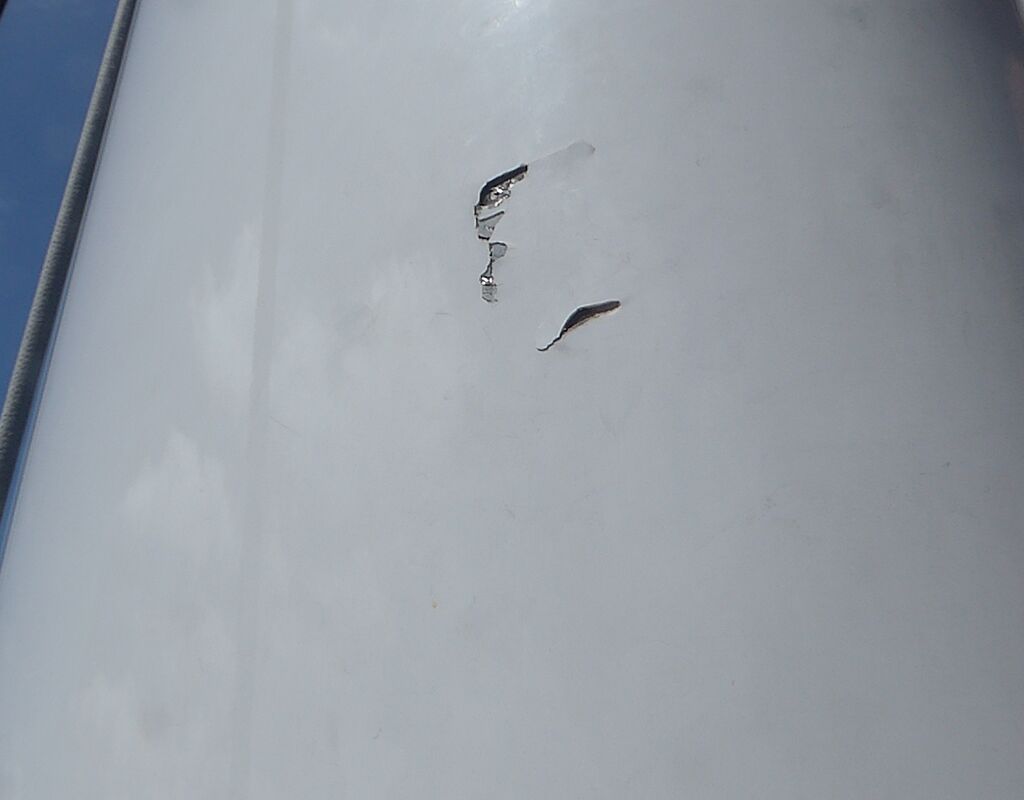
The first assessment of the damage on the mast of Cygnus Montanus wasn’t bad, says MCS’ Felix Bussmann
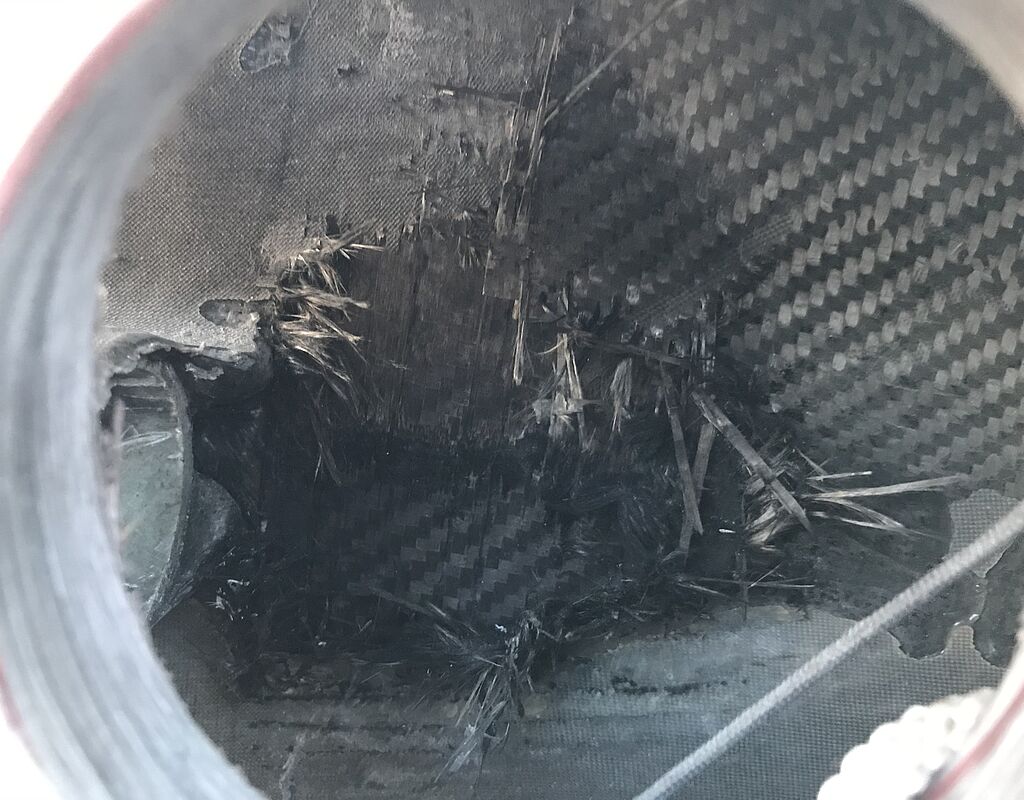
Visual inspection with a camera showed delamination inside the mast of Cygnus Montanus
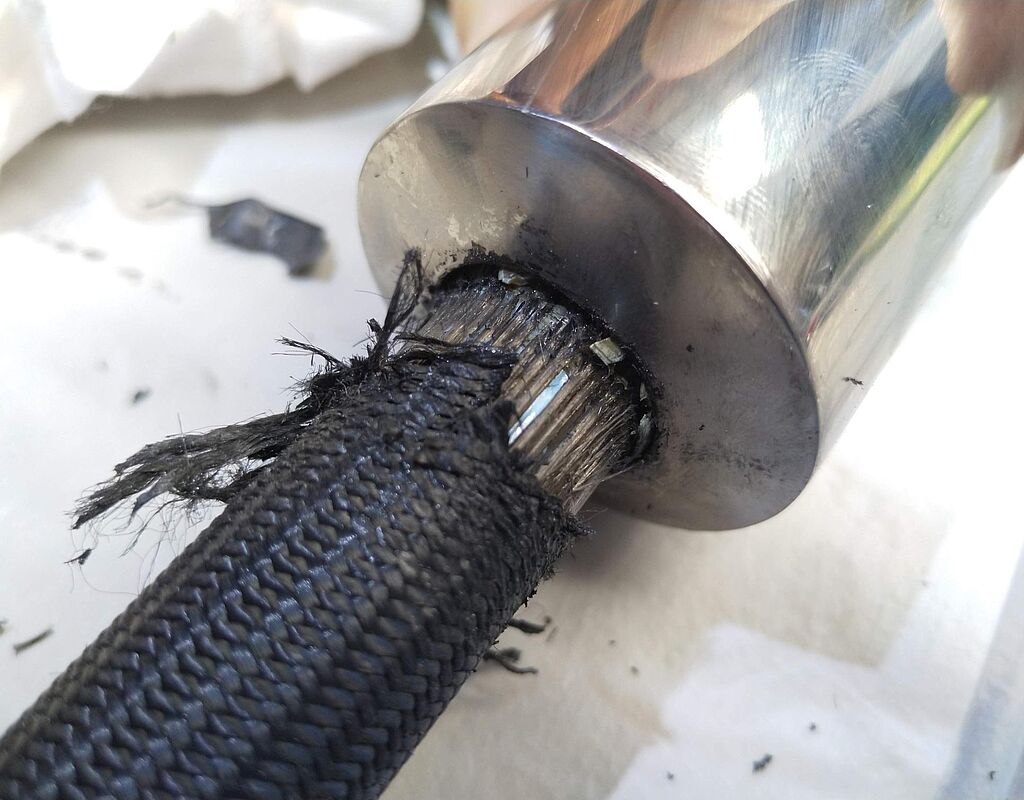
Substantial damage to composite rigging due to lightning strike
A third example disproves the old adage “lighting never strikes twice...” An incredibly unfortunate 122ft Vitters has been struck a total of three times. The first instance occurred during transportation through the Pacific, during which she suffered damage to her rod rigging, mast, and hull. The second instance took place in Costa Rica, after which ultrasound showed no damage to the mast, but further visual inspection revealed rigging damage that required replacement of the yacht’s composite cables.
After these two incidents, the yacht was fitted with a full lighting protection system, this included becoming one of the first yachts to receive DAME Design Award-winning LiMit (Lighting Mitigation) Collars from Future Fibres (a breakthrough biproduct of the research project explained in more detail below). When a third strike was detected in Costa Rica, she showed no signs of damage to her rigging or mast.
Looking Closer: The Research Project
In 2017, Southern Spars, Future Fibres and RigPro launched an ambitious R&D project. The objective was to delve into lightning strikes and their impact on yachts, and ultimately to mitigate their effects, particularly with regards to composite rigs and rigging.
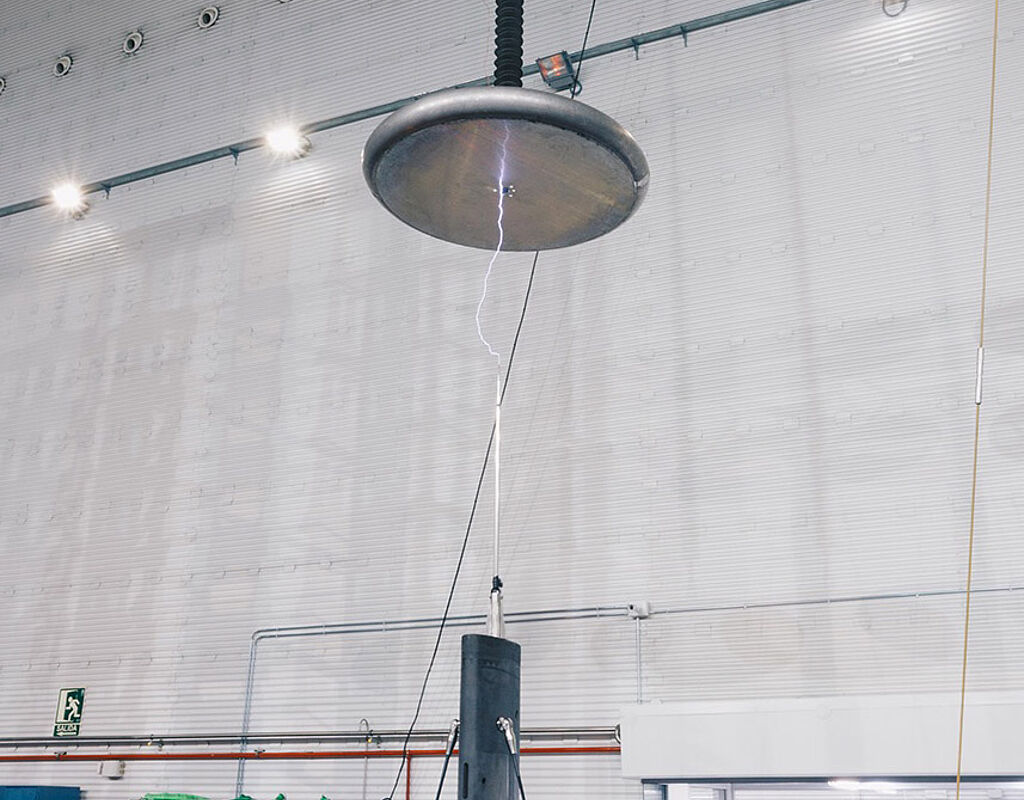
North Technology Group replicated 350 lightning strikes to delve into the impact on rigs and rigging
To guarantee depth and precision the project complied with aerospace standards. Lightning strikes can manifest with exceptionally high currents. To replicate this, currents of up to 200kA were produced in Europe’s leading certified labs – LCOE in Madrid and Labelec in Barcelona – where over 350 lightning strikes were replicated.
Comprehensive composite spar and rigging testing was undertaken. Initial findings suggested that composite rigs bear the brunt of damage from direct impact, after which point arcing has a key role to play in ensuing damage to composite rigging. Arcing occurs when lightning current jumps between different materials, for example, composite rigging and metallic end fittings. In addition to spars, shrouds were found to be primary conductors and damage to other equipment was found to be caused by induced currents—so enhancing lightning protection for both rig and rigging was proven to be paramount, not only to protect these elements but also to protect customers’ other investments.
What Can You Do?
Lightning is unpredictable and unavoidable. Even if you employ every precaution, at this time, there's no comprehensive solution that can guarantee protection. However, this extensive research has yielded solutions that have the potential to minimize damage, avert arcing, and efficiently absorb current.
During this project, countless materials, architectures, sizes, and environmental conditions were tested for both rig and rigging solutions. One of the breakthroughs of this study was the introduction of LiMit Collars. Although not a panacea, rigging with LiMit Collars demonstrated no strength reduction during post-strike tests, while also facilitating easy inspection and replacement. LiMit Collars now come as standard with the world’s most popular composite rigging (ECsix) on all rigs above 100 feet.
In addition to this, enhancements have been made to rig designs. Strike counters ensure crews are aware of lightning incidents, changes have been made to reduce arcing between elements, new spike designs have been introduced and air terminal designs, and down conductors have been refined. All RigPro service providers are now also equipped with lightning assessment protocol to evaluate any lightning incidents onsite.
While there is no way to be 100 per cent safe from lighting damage, for now, the best course of action is to source expert opinion and ensure you have an up-to-date, professionally installed lighting protection system in place.
For those eager to delve deeper into this subject, please contact info@futurefibres.com for more details about the research project and resulting solutions.
Pantaenius handles between 150 and 250 claims of lightning damage to boats per year. Although this figure is just a small percentage of the total amount of claims, the individual sums caused by lightning are usually twice as high as the average reference value in the Pantaenius damage statistics.
“To encourage prevention, Pantaenius offers to reduce the deductible that usually applies in regions prone to light strikes, such as the Mediterranean. If the yacht has a technically functional lightning protection system, no deductible will apply for damage caused by lightning strikes. In most cases, a lightning protection system cannot prevent lightning strikes, but it should be able to reduce the effects of lightning damage to the yacht”, says Gideon Fey from the claims department. For more info, get in touch with superyacht@pantaenius.com